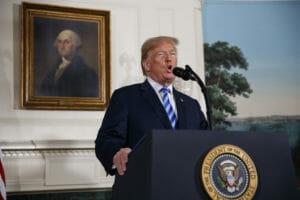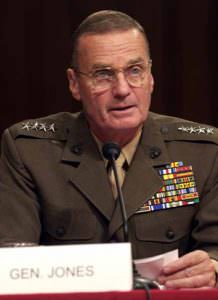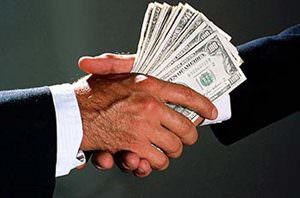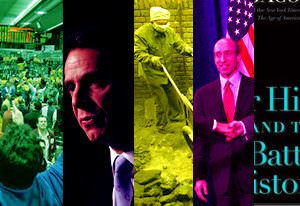Where’s the Top Gun?
Well, that didn't work out. In pushing for a new financial industry bailout, Treasury Secretary Geithner came across like a banker trying to do a politician's job. Obama owes us some hands-on involvement.Well, that didn’t work out.
The split-screen image of Treasury Secretary Timothy Geithner’s speech on a new-and-we-all-hope-improved financial industry bailout plan was of a banker trying to do a politician’s job while the markets he was trying to calm jumped off the cliff. Things got worse when Geithner went before the Senate Banking, Housing and Urban Affairs Committee to explain himself. How much worse?
Ardently liberal Democrat Christopher Dodd of Connecticut was talking almost precisely the same way as the uncompromising conservative Republican Richard Shelby of Alabama.
“What is your goal? What is the intention? What is the purpose of all this?” an incredulous Dodd asked. “We are talking in denominations that are daunting.”
And Shelby’s message? “Is there a concrete plan here? And if so, how do we assess it?”
The short answer is no, there is no concrete plan. Neither are there concrete numbers, though the presumption from the Treasury Department is something on the order of $2 trillion to be pumped into the financial system.
There are some intriguing ideas that, if implemented, might protect taxpayers, such as giving public guarantees to private investors so they will buy the so-called toxic assets on bank balance sheets that are causing lending to slow or freeze. This is the hybrid scheme Treasury came up with after rejecting the idea of creating a “bad bank” in which the public — that is, the taxpayers who have already pumped billions into the failing financial sector — purchases the nasty and possibly worthless stuff outright.
Still and all, we are not much closer to understanding the Obama administration’s approach to the credit crisis than we were before Geithner went before the cameras. Except that there are the usual pledges of transparency, much of which are supposed to be met by the creation of — guess what? — another Obama administration Web site!
Now, the Internet is a wonderful way for the public to gain access to information. But I am getting weary of the administration’s talking point that so long as something is posted on the Web, that makes it OK. The president’s inaugural committee donors were listed on the Web, but the list was dominated by high-roller contributors who “bundled” money and got credit for bringing in as much as $300,000 each. Making this public was terrific, but did that make it right?
Another intriguing effort at “transparency,” as outlined by Geithner, is the requirement that banks undergo a “stress test” before receiving more infusions of public capital. A thorough scrubbing of the balance sheets would presumably expose some banks as too shaky to survive. “What will you do if your ‘stress tests’ of major banks revealed that some are insolvent?” asked Sen. Jim Bunning, R-Ky. Geithner wouldn’t say, indicating it would be “irresponsible” — presumably because he might cause a run on a bank (or two, or three). And really, his day was already going badly enough.
It seems that Geithner may have been an asset poorly used. He is a banker used to negotiating in conference rooms, not navigating the media scrum. The next round of the financial industry bailout must be too big to fail — a point Geithner made repeatedly. But doesn’t that mean it should be promoted by the administration’s best performer?
That would be President Obama. If there was a White House strategy behind the rollout of the financial industry plan, it was invisible. So, effectively, was the president.
While Geithner was bleeding in Washington, Obama was bonding with Florida voters at a campaign-style appearance to promote an economic stimulus package that already is nearing completion. And though the president was in Fort Myers, a community ravaged by foreclosures, the administration has so far failed to detail how it will use bailout funds to help struggling homeowners.
Day after day last fall, as the financial crisis worsened and the government took step after step to intervene, you could read lengthy accounts that described the roles played by Federal Reserve Chairman Ben Bernanke and Treasury Secretary Hank Paulson. Curiously absent was any mention of the man who was supposed to be in charge: George W. Bush.
One reason Obama won is that the public had more than its fill of a disconnected president. Now Obama owes us some hands-on involvement, even if that means his hands get dirty with an unpopular program for the nation’s most despised industry.
Marie Cocco’s e-mail address is mariecocco(at)washpost.com.
© 2009, Washington Post Writers Group
Your support matters…Independent journalism is under threat and overshadowed by heavily funded mainstream media.
You can help level the playing field. Become a member.
Your tax-deductible contribution keeps us digging beneath the headlines to give you thought-provoking, investigative reporting and analysis that unearths what's really happening- without compromise.
Give today to support our courageous, independent journalists.






You need to be a supporter to comment.
There are currently no responses to this article.
Be the first to respond.